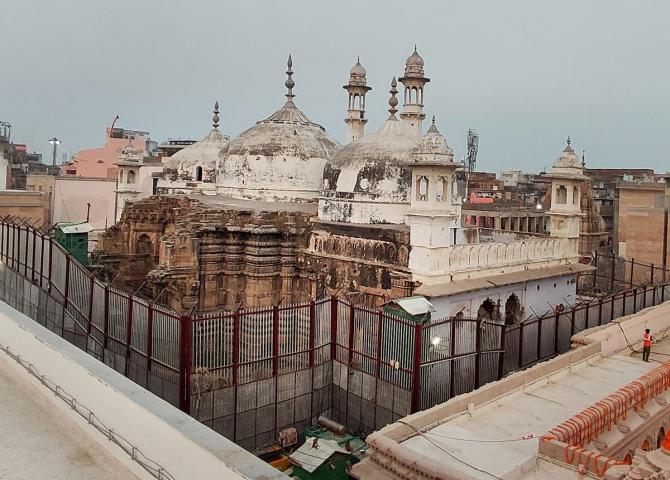'Why were they silent when over 128 temples and shrines including Shivlings were broken down at the time of the construction of the Kashi Vishwanath corridor?' a Varanasi resident asks Rashme Sehgal.

The spectre of yet another mandir-masjid conflict is upon us.
There has been a tremendous ratcheting up of emotions around the claim of a sudden discovery of a Shivling in the Gyanvapi mosque complex in Varanasi.
A petition by five women petitioners asked to be allowed to conduct prayers round the clock inside the mosque.
This led a civil judge to order a videographic inspection that led to the discovery of the Shivling.
Literally overnight, the status of the mosque among the public has been 'metamorphosed' to that of a temple with the concomitant plea to be allowed to pray there.
These shrill demands of worship are very reminiscent of the Ayodhya Ram Janambhoomi-Babri Masjid dispute which saw idols of Lord Ram being placed surreptitiously in the dead of night on December 22, 1949, inside the Babri Masjid.
In Varanasi also, a number of citizens have started referring to the Gyanvapi mosque as being a temple site and their legitimate demand to pray must be acceded to.
The parallels are uncanny. Once the locks of the Babri Masjid were opened in 1986 by then prime minister Rajiv Gandhi, it was only a matter of time for this issue to hold centre stage with the Vishwa Hindu Parishad being given permission to perform shilanyas in November 1989.
This was followed by L K Advani embarking on a rath yatra in 1990, catalysing a chain of events that saw the BJP catapult from 85 seats in the 1989 Lok Sabha election to 120 seats in the 1991 general election.
There is little doubt that the Gyanvapi mosque was built on the foundation of the famed Vishweshwara temple that Aurangzeb destroyed in 1669.
Almost a century later, Maratha queen Ahilya Holkar set in motion a process of reconciliation between the Hindu and Muslim communities by getting the Kashi Vishwanath temple rebuilt around 1870 and prayers have been taking place there ever since.
Though the temple and mosque abut each other, their entry and exit points have been different and for all these years, for Hindus this has been considered a very sacred place.
Varanasi-based editor and writer Aflatoon points out, "For millions of Indians who have visited the Kashi Vishwanath temple, they have prayed before none other than the Shivling considered the most prominent of the 12 Jyotirlings of Shiva."
Aflatoon questions the religiosity of the bhakts clamouring to convert the Gyanvapi mosque into a temple.
"Why were they silent when over 128 temples and shrines including Shivlings were broken down at the time of the construction of the Kashi Vishwanath corridor?" he asks.
"All these so-called bhakts are operating on a premeditated agenda laid out by the VHP-BJP," he charges.
S M Yaseen, joint secretary of the Anjuman Intezamia Masjid Committee, had expressed his apprehensions over the Gyanvapi mosque meeting the same fate as the Babri Masjid when work had just started on the Kashi Vishwanath corridor.
"In early 1991-1992, a great deal of road widening was done around the Babri Masjid to increase access to the masjid site though the plea taken was that it was being done to beautify the area around the mosque," recalls Yaseen.
In the same way, Mufti Adul Baatin Nomani, imam of the Gyanvapi mosque, warned against the widening of the narrow lanes leading up to the temple and the mosque.
'Now over two lakh people can be assembled here in no time,' Nomani had warned.
In 1985, when an advocate approached the district judge of Faizabad to open the gates of the Babri Masjid so Hindu devotees could worship the idols, the order was passed the following day and the gates were opened within minutes of the order being passed.
On April 8, 2022, a civil judge in Varanasi allowed a videographic survey of the Gyanvapi mosque by an advocate commissioner who discovered a Shivling in the water tank. This area has been sealed.
Hindu 'bhakts' claim it is a temple and demand they be allowed to worship there in contravention of the Places of Worship Act 1991 which freezes the status of shrines as on August 15, 1947.
So why was this inspection permitted despite the strong protests by the Muslim side?
During the Ram Janambhoomi case, the court commissioner's preparation of a map of the masjid way back in 1950 (on the order of the civil judge) proved the reference point for all future decisions of the high court as also the Supreme Court.
Apoorvanand, a Delhi University professor and columnist, believes the Supreme Court should have stayed the videography inside the Gyanvapi mosque.
Several attempts have been made in the past to turn this into a disputed site, but the move was stalled every time as a consequence of the Allahabad high court's intervention.
This time, when the Anjuman Intezamia Masjid Committee approached the Allahabad high court against the appointment of an advocate for 'inspection and survey' of the mosque, it set aside the stay order, thereby allowing this to become a disputed monument.
Since then, the Varanasi civil court has transferred the petition for Hindus to worship the Shivling to a fast track court which started hearing the matter from Monday, May 30.
Several leaders have warned against changing the status of the mosque. This should be obvious to all. Riots erupted across the country following the December 6, 1992, demolition of the Babri Masjid resulting in the deaths of several thousand Indians.
The country is hardly in a position to deal with more social unrest.
Note: I was present at the fall of the Babri Masjid on December 6, 1992, and had an eyewitness account of the burning and looting that started soon after it came down.










